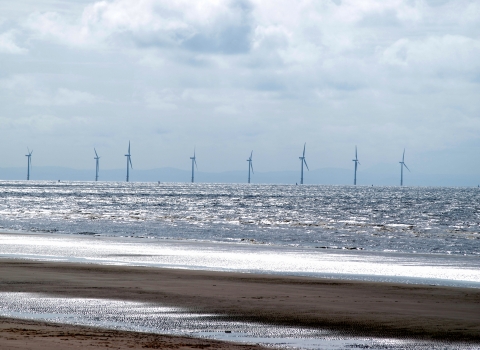Sustainable development
We believe that development at sea should be environmentally sustainable. It should do as as little harm to the environment as possible regardless of what the development is. Development should take place using the right technology in the right place and make a positive contribution to nature’s recovery at sea.
Part of nature's recovery
Our seas need to be managed to recover from past damage, disturbance and neglect. With the demands on our seas for resources and energy, the scale of future development is increasing. Future development needs to take place in a sustainable way to allow nature’s recovery within our seas to take place. Offshore renewables, particularly offshore wind, is a fast-growing industry. Although producing green energy, the construction of offshore wind farms has environmental impacts like any other marine development. Impacts can include loss and disturbance to habitats and species. In particular we are concerned about the impact of underwater noise from construction on marine mammals, which are particularly sensitive to noise.
What are we doing?
Due to the scale of offshore marine renewable developments, we are engaging closely with this sector. The impacts from the scale of developments, are not fully understood. We engage on individual developments through the life span of the project to ensure minimal impact on the marine environment. We engage closely with the Government, regulators and statutory nature conservation bodies to influence policy at a national level.
Sabellaira reef at Allonby Bay ©NWIFCA
Large scale developments across the North West
From projects looking into the feasibility of tidal lagoons to a new nuclear facility, the expansion of old mines and the discharge of hypersaline solution from salt caverns, we work to ensure that the impact on marine life and protected areas is taken into consideration.
The scale of offshore wind development
Offshore wind farms are not simply ‘onshore wind farms at sea’; they are on a much larger scale. A single onshore wind turbine has a capacity of around 2.5 MW and the average size of an onshore wind farm is only 7 turbines. The offshore wind farm projects applying for planning permission are looking to use wind turbines with a capacity of up to 20 MW each and each project could have an average of 300 turbines.
The world's largest wind farms located in the North West
In 2017, Ørsted built the world's largest offshore wind turbines at Burbo Bank Extension of the Merseyside Coast. In 2018, the construction of the Walney Extension, off the coast of Cumbria, was finalised. The extension alone is made up of 87 turbines (taller than the Blackpool Tower), has a total capacity of 659 MW and covering an area of 20,000 football pitches.
Moreover, three out of the four new Offshore Wind Leasing Round 4 projects are in the Irish Sea. Two are a consortium between Energie Baden-Württemberg AG (EnBW) and BP; Morgan and Mona will have a combined potential generating capacity of 3 gigawatts (GW) – enough to power 3.4 million homes - they are approximately 300km² and 500km² in size respectively, located approximately 30km from the coast. The third is a smaller venture between a Spanish company and a floating energy company, so may be expected to be a floating wind farm. The Crown Estate is currently conducting the Round 4 Plan-Level Habitats Regulations Assessment (HRA) to assess the potential impacts of the six projects identified through the Round 4 tender process (the “Round 4 plan”) on the network of protected areas covering the UK's most valuable species and habitats. It must be completed before awarding seabed rights which is expected to be in 2022.
Our work also focuses on the impacts of underwater noise from the construction of offshore wind farms. Construction can cause large levels of noise to radiate into the marine environment. This has the potential to cause injury and disturbance to marine mammals. We believe noise reduction plans should be implemented at a whole seas level.
Marine Planning
We use the sea in a variety of ways. From fishing, to aggregates, to recreational use we make huge demands on the marine environment. Marine plans aim to set out the sustainable use of our seas. The Marine Management Organisation is responsible for the creation of marine planning. Currently there are 10 marine plan areas, including the North West. See below for how we have been involved in their development.
We believe more could be achieved through marine planning. We want to see a regional seas approach to marine spatial planning. This would create wildlife areas, resource areas and sustainable fishing areas. Read our report to find out more:
Seal surveying
The development of the North West Marine Plan
We responded to consultations, took part in workshops and provided information to aid the development of the North West Marine Plan to ensure that marine plans leave a space for wildlife.

